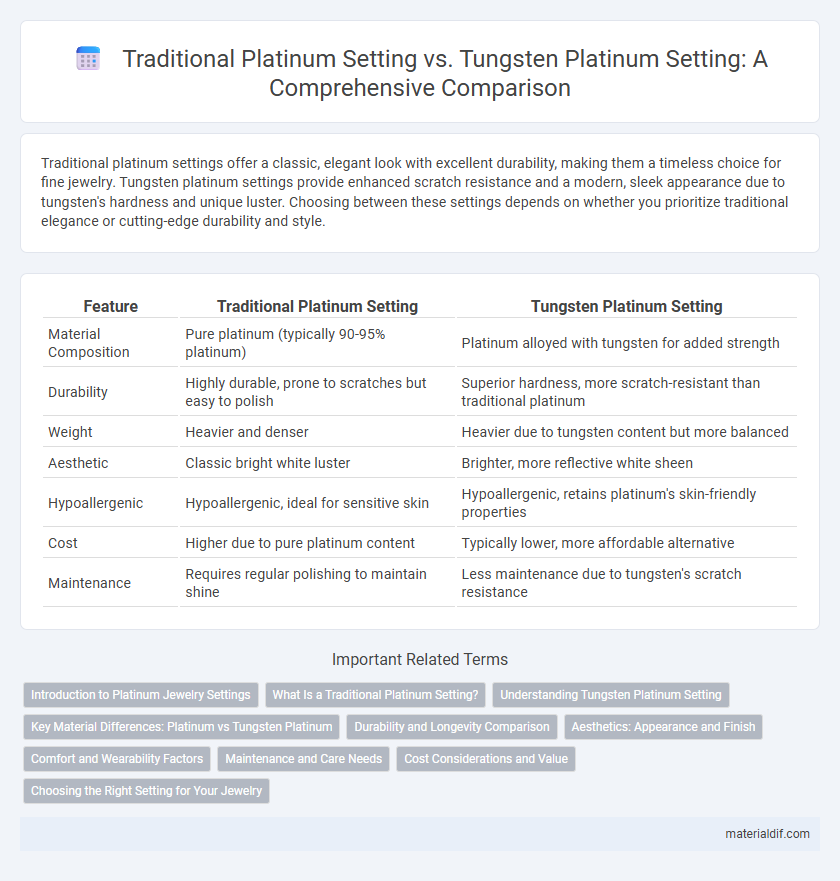Traditional platinum settings offer a classic, elegant look with excellent durability, making them a timeless choice for fine jewelry. Tungsten platinum settings provide enhanced scratch resistance and a modern, sleek appearance due to tungsten's hardness and unique luster. Choosing between these settings depends on whether you prioritize traditional elegance or cutting-edge durability and style.
Table of Comparison
| Feature | Traditional Platinum Setting | Tungsten Platinum Setting |
|---|---|---|
| Material Composition | Pure platinum (typically 90-95% platinum) | Platinum alloyed with tungsten for added strength |
| Durability | Highly durable, prone to scratches but easy to polish | Superior hardness, more scratch-resistant than traditional platinum |
| Weight | Heavier and denser | Heavier due to tungsten content but more balanced |
| Aesthetic | Classic bright white luster | Brighter, more reflective white sheen |
| Hypoallergenic | Hypoallergenic, ideal for sensitive skin | Hypoallergenic, retains platinum's skin-friendly properties |
| Cost | Higher due to pure platinum content | Typically lower, more affordable alternative |
| Maintenance | Requires regular polishing to maintain shine | Less maintenance due to tungsten's scratch resistance |
Introduction to Platinum Jewelry Settings
Platinum jewelry settings are prized for their durability and natural white sheen, making them ideal for showcasing gemstones. Traditional platinum settings often feature handcrafted prongs and intricate detailing, enhancing the brilliance of diamonds while providing strong support. Tungsten platinum settings combine the hardness of tungsten with platinum's luster, offering increased scratch resistance and a modern aesthetic for contemporary jewelry designs.
What Is a Traditional Platinum Setting?
A traditional platinum setting features a classic design where the platinum metal is carefully crafted to securely hold and showcase gemstones, often using prongs or bezels for maximum durability and elegance. This type of setting highlights platinum's natural white sheen, providing a timeless and hypoallergenic option favored for engagement rings and fine jewelry. Compared to tungsten settings, traditional platinum offers superior malleability, allowing intricate designs and easier resizing for personalized adjustments.
Understanding Tungsten Platinum Setting
Tungsten platinum setting combines the durability of tungsten with the elegance of platinum, offering a more scratch-resistant and robust option than traditional platinum settings. This hybrid setting enhances the ring's longevity while maintaining platinum's naturally hypoallergenic properties and lustrous finish. Tungsten platinum settings provide increased strength and are ideal for those seeking a balance between toughness and classic luxury.
Key Material Differences: Platinum vs Tungsten Platinum
Traditional platinum settings offer exceptional purity and malleability, allowing jewelers to create intricate designs with a naturally white, hypoallergenic metal. Tungsten platinum settings combine the durability and scratch resistance of tungsten with the luxurious appearance of platinum, resulting in a hybrid material that is harder but less malleable than pure platinum. The key difference lies in tungsten's increased hardness and weight, which enhances durability but reduces flexibility compared to the classic softness and high ductility of traditional platinum.
Durability and Longevity Comparison
Traditional platinum settings offer exceptional durability due to their malleable nature, allowing secure gemstone placement while resisting wear over time. Tungsten platinum settings combine the hardness of tungsten with platinum's luster, resulting in enhanced scratch resistance and increased longevity under daily wear conditions. Comparing durability, tungsten platinum settings generally outperform traditional platinum by maintaining structural integrity and appearance longer, making them ideal for active lifestyles.
Aesthetics: Appearance and Finish
Traditional platinum settings offer a classic, luminous finish characterized by a soft, white sheen that enhances gemstone brilliance, maintaining a timeless elegance. Tungsten platinum settings exhibit a more modern, polished look with a subtle grayish tint, providing increased scratch resistance and a sleek, contemporary appeal. The choice between these settings depends on preference for either the warm, radiant luster of traditional platinum or the durable, matte finish associated with tungsten alloy blends.
Comfort and Wearability Factors
Traditional platinum settings offer superior comfort due to their smooth, rounded edges and lightweight design, making them ideal for everyday wear. Tungsten platinum settings, while highly durable and scratch-resistant, tend to be heavier and less flexible, which can impact long-term wearability. The choice between the two depends on prioritizing either comfort and ease of wear or maximum durability and resistance to wear.
Maintenance and Care Needs
Traditional platinum settings require regular polishing to maintain their luster and are more prone to scratching due to the malleability of platinum. Tungsten platinum settings offer superior scratch resistance and durability, reducing the frequency of maintenance but require professional care to avoid damage from heavy impact. Both settings benefit from routine inspections to ensure prongs are secure and prevent gemstone loss.
Cost Considerations and Value
Traditional platinum settings, known for their classic durability and hypoallergenic properties, generally come at a higher initial cost due to the labor-intensive crafting process and the higher purity of platinum used. Tungsten with platinum plating offers a more affordable alternative, combining the strength and scratch resistance of tungsten with the prestigious look of platinum, but may lack the long-term value and repairability of solid platinum. When considering overall investment, traditional platinum settings retain value better due to their rarity and the ability to resize or repair, whereas tungsten platinum settings prioritize cost savings and durability but may require replacement over time.
Choosing the Right Setting for Your Jewelry
Traditional platinum settings offer exceptional durability and a classic, timeless appearance, making them a popular choice for high-end jewelry that showcases precious gemstones. Tungsten platinum settings combine the strength and scratch resistance of tungsten with the luxurious shine of platinum, ideal for customers seeking modern, long-lasting pieces with minimal maintenance. Selecting the right setting depends on balancing personal style preferences, lifestyle considerations, and the specific characteristics of the metal's wear resistance and aesthetic appeal.
Traditional Platinum Setting vs Tungsten Platinum Setting Infographic

 materialdif.com
materialdif.com